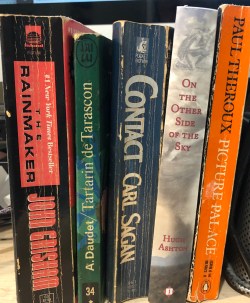Here’s another for my reading list – Cabala, Spiegel Der Kunst Und Natur, In Alchymia (that is, if I can find a copy anywhere and then make my way through old German). It incorporates some of my favourite subjects: mirrors, Kabbala, alchemy, and general Rosicrucian mysticism.
Note that the links here are to both nature, as you would expect from a science, but also to art. Alchemy was much more than simply attempting to turn metals into gold, or even seeking the philosopher’s stone. It’s a way of reconciling the heavens and the earth (all the astrological and alchemical equivalences).
But much more than this, there is a link with spirituality. The quest is a spiritual perfection, or gold, to be created through the transformation of vulgar matter – the human condition, or lead. To see this (astrology) as merely “what are the stars telling us?” or (alchemy) as a get-rich scheme (though there were certainly frauds and hucksters who played on this) is to miss the point.

Links between the two proto-sciences
I call these (alchemy and astrology) “proto-sciences” because in many ways they operated in the same way as modern scientific methods. There was meticulous measurement, an insistence on replication, and a theoretical underpinning (mistaken, but complex) guiding the processes.
The links can be clearly seen in the diagram here. We have the different alchemical processes linked not only to the signs of the zodiac, but also to the “planets“ and the “elements”. As you can see from the chart below, though, there is not always a consistency in the symbols used (the same discrepancies sometimes exist in modern science).
However, note the importance of the four Paracelsian “elements” in both charts: fire, water, earth, and air, which of course are represented by the Elementals: Salamanders, Undines, Gnomes, and Sylphs. All of these, of course, come into On the Other Side of the Sky as key plot ingredients as well as adding to the general ambience of the story..

Of course, both of these disciplines, alchemy and astrology, were starting from mistaken premises regarding the fundamental nature of things, but the idea of influence at a distance, which formed part of the astrological foundation, and also found expression in the idea of the Powder of Sympathy, and “weapon salve” was in some way responsible for Newton (a passionate alchemist) developing his appreciation of gravity and the laws governing it.
Mirrors – always a subject of fascination to me. Susanna Clarke uses mirrors most effectively in Jonathan Strange & Mr Norrell as gateways to Faerie. I also use a bowl of water, acting as a magical “mirror” orscrying glass – and I am constantly fascinated by what lies on the other side of mirrors (as was Lewis Carroll, of course).
It’s clear that this worldview (the synthesis of astrology and alchemy) is holistic – taking into account the physical and the spiritual aspects of this world, and also the heavens. It’s not a “simple” or primitive model of the universe, even if it doesn’t correspond to what we now know, but it all comes together to create a system which is far from being nonsense, and it continues to hold my interest as a psychological view of the world (an interest also shared by Jung, of course).







